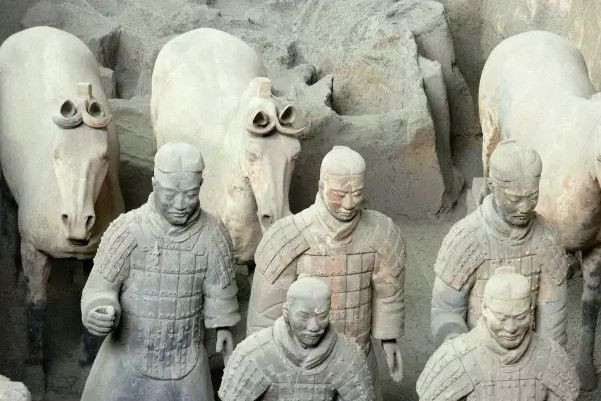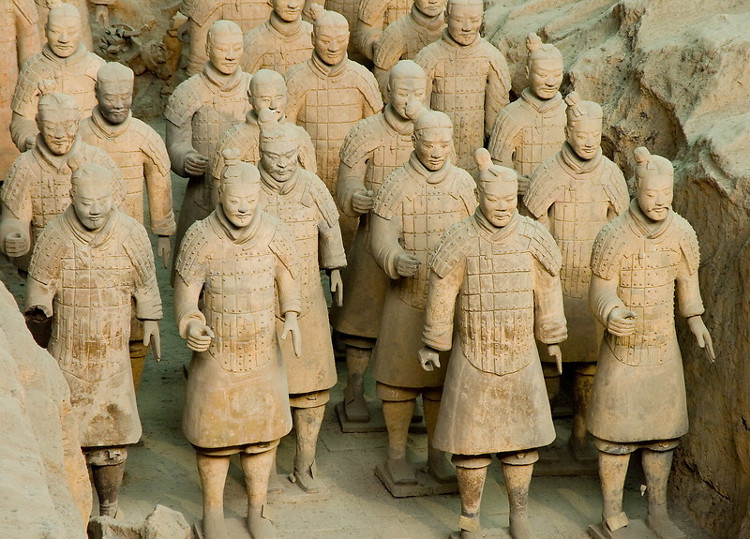Excavating the tomb of Qin Shui Huang, discovering the animal world inside
Recent archaeologists recently discovered in the tomb of Qin Shihuang there are thousands of animals of different species that have been buried with him, this is an emperor's tomb containing the most animals of China. find.
According to preliminary statistics, among the animals in the tomb, the horse is the most abundant animal, this number consists of three types of earthen horses in the three vaults of Binh Ma Dung 1, 2, 3, and bronze horses. Bronze and horse-cart trailers in horse stables. The second most abundant species are rare animals and waterfowl, in addition to a large number of animal bones awaiting verification of which species.

In a tomb, horses are the most numerous animals.
Vo Le Na is a worker in charge of research at the Tomb of Emperor Qin Shihuang said, animals excavated from Qin Shihuang tomb have extremely rich categories, including animals buried alive and Terracotta animals, in bronze. To a certain extent, excavation results have reflected the daily lives of the people of the Qin Dynasty, who have captured the behavior of animals, thus knowing how to nurture and use them.
Research shows that the ancients especially value life in the "negative" world after death, preparing them for life as a life on earth. The old people in burial often have to bury the pets together, in Egyptian tombs there are also cat, dog, crocodile models etc. In the tombs of ancient Chinese emperors there are also specialized animals. used as food and "pet as a sight" for humans.

Terracotta army in the tomb of Qin Shihuang.
The archaeological process has shown that the number of animals used in Qin has at least 12 species. In ancient times horses were fighting forces so this species always occupied a special place; deer is a wild animal that specializes in hunting; species of crab and goat chicken are used as food; crustaceans such as clams and snails are used as jewelry; birds like swans, cranes are caged in cages as pets.

The archaeological process has shown that the number of animals used in Qin has at least 12 species.
Vo Le Na said that some rare herbivores such as deer, muntjac and some omnivorous animals have been excavated in cellars of rare animals. The total number of unearthed water tunnels was 46, of which 6 were found in the crane, 20 were swan, the rest were red and other species; At the grave in Thuong Tieu village, jewelry was found with shells of crustaceans, goat bones, chicken bones, pearl beads north of the grave; At the No. 1 grave in the north of the tomb, bone samples of more than 10 species of birds, animals and fish are found
Mr. Chau Thiet - the chief engineer of the museum of the tomb of Qin Shihuang earlier said that in the tomb area of Emperor Qin Shihuang discovered more than 400 burial tunnels large and small, around discovered dozens of graves and burial tunnels of different sizes, which contain a large amount of armor, hats etc. all of which are made of stone.

Portrait of Qin Shihuang.
The documentary shows that the tomb of Qin Shihuang is the tomb of the first Chinese emperor. The tomb area was built in 247 to 208 BC in Liishan area of Lam Dong, 31km east of Xi'an City in Shaanxi Province, this area is called Le Son area. five years old.

The tomb area was built from 247 to 208 BC in Liishan area of Lam Dong, from Xi'an City.Shaan Province.West China.
Qin Shihuang was the first Chinese emperor, in Chinese civilization five thousand years, this is the greatest, most scheming, great emperor of China, in his nearly 50-year life, he has done great things like unification, affirmed the "emperor" position , abolished the old regime, divided the country into districts, set up a management system at all levels and unified writing, unifying measuring and monetary instruments, unifying laws and regulations, making lanes with lanes, building Truong Thanh Ly, building canals, building Cung A Phong. He left behind a very mystical tomb of Lishan.
- The mystery of the tomb Qin Shihuang
- China suspended excavation of the tomb of Qin Shi Huang
- Why hasn't China dared to excavate the tomb of Qin Shui Huang?
- Excavating Egyptian tomb 3,500 years contains mummies
- Excavating the tomb over 2000 years old, discovering party pictures and nude painting on the wall
- China excavated the tomb of Qin Shihuang's grandmother
- 600-year-old citadel in Xi'an
- The deadly weapon of the terracotta army, the tomb of Qin Shi Huang
- Found a thousand-year-old beef soup in a tomb
- Excavation of the tomb of Queen Cao Cao's grandson
- Found the palace in the tomb of Qin Shihuang
- Video: Touch the dog to find the owner on the bus every day
 Discovered an ancient centipede fossil 99 million years old
Discovered an ancient centipede fossil 99 million years old Discovered bat-like dinosaurs in China
Discovered bat-like dinosaurs in China Discovered a 200-year-old bronze cannon of the coast
Discovered a 200-year-old bronze cannon of the coast Discover 305 million-year-old spider fossils
Discover 305 million-year-old spider fossils